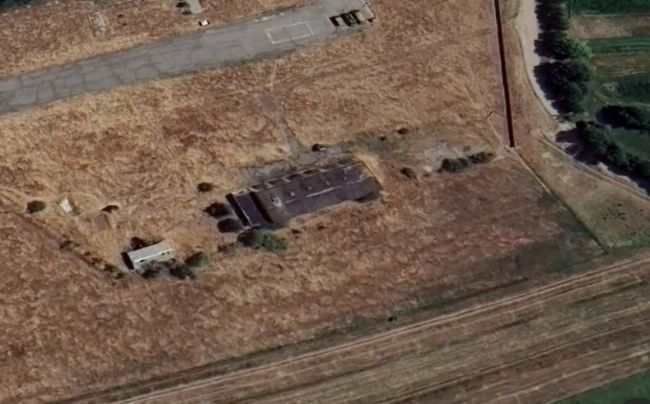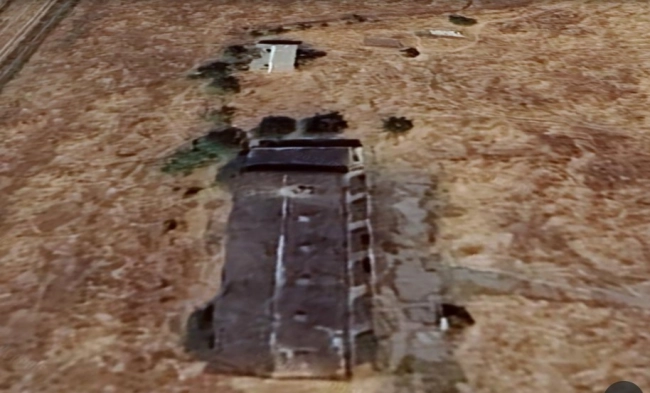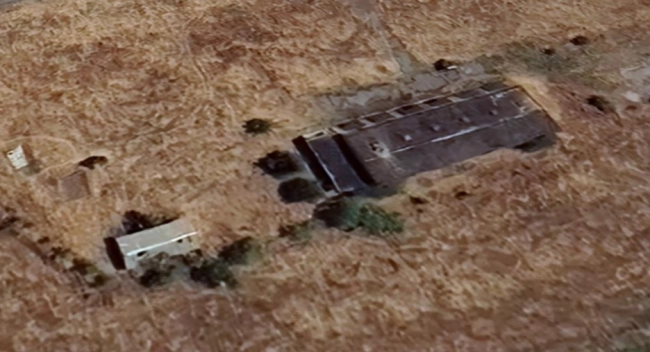Osh Region Warehouse in the Village of Saray (Ministry of Defense)
Coordinates: 40.670935, 72.888856
In the Osh region, according to previous inventories, two sites were identified, both of which had clear coordinates (WS-214 warehouse in the village of Saray (under the Ministry of Defense); WS-215 Airfield in the village of Chek-Abad).
At the WS-215 Airfield site in the village of Chek-Abad, the area was completely dug up, with a large amount of construction and household waste. According to local residents, the last barrels were taken away by the military.
The point is located near agricultural land (the warehouse is completely destroyed, no traces of obsolete pesticides were found, and there is no smell). The area is completely abandoned and has parts of destroyed buildings. The total amount of contaminated soil is difficult to estimate, with contaminated areas approximately 5 cubic meters.
The WS-214 warehouse in the village of Saray is under the Ministry of Defense (restricted facility). It is impossible to establish the presence of a warehouse that meets safety requirements, as access to the restricted facility is limited by the security of the Armed Forces of the Kyrgyz Republic. There are reporting data on repackaging. The repackaged waste with obsolete pesticides was not officially transferred to the Ministry of Defense upon the transfer of 12 hectares of land where the warehouse with repackaged pesticides was located. Waste passports are absent.
To date, despite the abundance of previously conducted projects on the inventory of obsolete pesticides, contrary to national legislation:
• there are no laboratory data bases on the composition of the waste;
• waste passports are absent;
• regular monitoring of the condition of obsolete pesticide waste is not conducted (only within the framework of international projects);
• there is no executive authority responsible for the storage and disposal of waste;
• insufficient laboratory capacity for conducting analyses on obsolete pesticides, including POPs;
• information on the composition of obsolete pesticides is absent in the regulatory bodies;
• additional research is required on the owners of some warehouses/land where the points with obsolete pesticides are located.
• training for local government employees, regulatory and supervisory bodies is necessary;
• responsibility for improper handling of hazardous waste needs to be tightened.
Conclusions
In accordance with the Stockholm Convention on POPs (Article 6 (d) (ii)), waste containing POPs must be destroyed. To find environmentally acceptable methods for the destruction of obsolete pesticides, the exact composition of the waste is necessary. This requires addressing the issue of equipping laboratories, training personnel, and obtaining accreditation in accordance with GOST ISO/IEC 17025-2019.
In addition, it is necessary to continuously monitor the condition of pollution points with obsolete pesticides and to repack and place waste in a temporary storage warehouse that meets national legislation requirements. Repackaging, construction of a temporary storage warehouse, and destruction must be accompanied by an EIA procedure and obtaining a positive conclusion from the state ecological expertise. For all waste, the owner must present waste passports and obtain permits for the storage of hazardous waste.
The process of storing and destroying hazardous waste must be under the control of environmental regulatory bodies.
To this end, it is necessary to initiate the process of maximum legalization of the data obtained from the inventory.
Previous inventories did not become the basis for creating a monitoring system for the management of obsolete pesticides. As a result, a large volume of uncontrolled hazardous waste has become a threat to the environment, life, and health of the population living near the points of placement of obsolete pesticides.
Full report on the inventory of obsolete pesticides (OP) in Chui, Talas, Naryn, Issyk-Kul, Jalal-Abad, Osh, and Batken regions
The warehouse is located at a restricted facility of the Ministry of Defense of the Kyrgyz Republic. Access to the warehouse was limited. According to the staff, the warehouse is on the premises and corresponds to the provided photographs. Nitrafen - 3 barrels x 25 liters. containers = 75 liters. During the "Familiarization visit and study of the situation with obsolete pesticides in the Kyrgyz Republic," it was decided to start a pilot project for the elimination of obsolete pesticides in the Osh region. According to the project, an inventory was conducted at 25 former pesticide storage sites using the standardized FAO inventory system (August-September 2007). Each storage site was described, and forms were filled out characterizing environmental risks and risks related to the quantity of pesticides available. The inventory showed that out of 25 sites, nine were completely lost due to the destruction of the warehouse buildings where the pesticides were stored, leading to the destruction of packaging, with pesticides being washed away and evaporated, contaminating the soil and, in some cases, likely groundwater and surface waters. The quantities of pesticides recorded during the inventory are as follows: 450 tons of obsolete pesticides, four tons of contaminated soil/dust inside the warehouses, and 160 tons of heavily contaminated soil with pesticides.
In the Osh region, according to previous inventories, two sites were identified, both of which had clear coordinates (WS-214 warehouse in the village of Saray (under the Ministry of Defense); WS-215 Airfield in the village of Chek-Abad).
At the WS-215 Airfield site in the village of Chek-Abad, the area was completely dug up, with a large amount of construction and household waste. According to local residents, the last barrels were taken away by the military.
The point is located near agricultural land (the warehouse is completely destroyed, no traces of obsolete pesticides were found, and there is no smell). The area is completely abandoned and has parts of destroyed buildings. The total amount of contaminated soil is difficult to estimate, with contaminated areas approximately 5 cubic meters.
The WS-214 warehouse in the village of Saray is under the Ministry of Defense (restricted facility). It is impossible to establish the presence of a warehouse that meets safety requirements, as access to the restricted facility is limited by the security of the Armed Forces of the Kyrgyz Republic. There are reporting data on repackaging. The repackaged waste with obsolete pesticides was not officially transferred to the Ministry of Defense upon the transfer of 12 hectares of land where the warehouse with repackaged pesticides was located. Waste passports are absent.
To date, despite the abundance of previously conducted projects on the inventory of obsolete pesticides, contrary to national legislation:
• there are no laboratory data bases on the composition of the waste;
• waste passports are absent;
• regular monitoring of the condition of obsolete pesticide waste is not conducted (only within the framework of international projects);
• there is no executive authority responsible for the storage and disposal of waste;
• insufficient laboratory capacity for conducting analyses on obsolete pesticides, including POPs;
• information on the composition of obsolete pesticides is absent in the regulatory bodies;
• additional research is required on the owners of some warehouses/land where the points with obsolete pesticides are located.
• training for local government employees, regulatory and supervisory bodies is necessary;
• responsibility for improper handling of hazardous waste needs to be tightened.
Conclusions
In accordance with the Stockholm Convention on POPs (Article 6 (d) (ii)), waste containing POPs must be destroyed. To find environmentally acceptable methods for the destruction of obsolete pesticides, the exact composition of the waste is necessary. This requires addressing the issue of equipping laboratories, training personnel, and obtaining accreditation in accordance with GOST ISO/IEC 17025-2019.
In addition, it is necessary to continuously monitor the condition of pollution points with obsolete pesticides and to repack and place waste in a temporary storage warehouse that meets national legislation requirements. Repackaging, construction of a temporary storage warehouse, and destruction must be accompanied by an EIA procedure and obtaining a positive conclusion from the state ecological expertise. For all waste, the owner must present waste passports and obtain permits for the storage of hazardous waste.
The process of storing and destroying hazardous waste must be under the control of environmental regulatory bodies.
To this end, it is necessary to initiate the process of maximum legalization of the data obtained from the inventory.
Previous inventories did not become the basis for creating a monitoring system for the management of obsolete pesticides. As a result, a large volume of uncontrolled hazardous waste has become a threat to the environment, life, and health of the population living near the points of placement of obsolete pesticides.
Full report on the inventory of obsolete pesticides (OP) in Chui, Talas, Naryn, Issyk-Kul, Jalal-Abad, Osh, and Batken regions






















Attention: Information based on submitted complaints